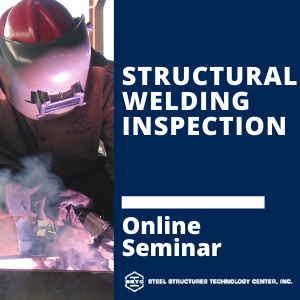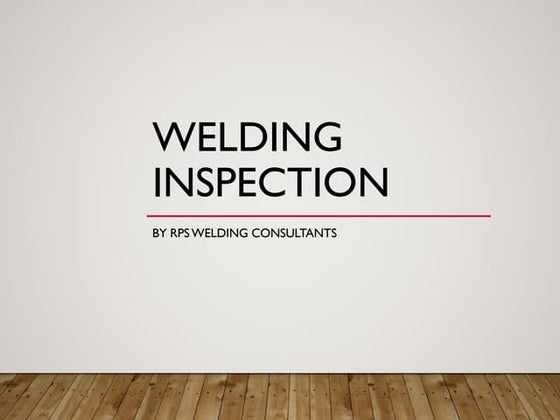The Ultimate Checklist for Welding Inspection Gilbert Arizona: Ensuring Safety and Precision
Wiki Article
A Comprehensive Guide to Welding Inspection: Understanding Specifications, Techniques, and Ideal Practices for Top Quality Guarantee

Welding evaluation plays an essential duty in ensuring the structural stability and security of bonded parts, demanding a comprehensive understanding of market requirements such as those developed by AWS and ASME. Numerous assessment strategies, consisting of aesthetic and ultrasonic testing, are employed to discover prospective problems that could compromise top quality. Applying finest methods can considerably enhance functional dependability and foster count on amongst customers. Welding Inspection Gilbert Arizona. As we check out these crucial components, it comes to be obvious that the ramifications of welding evaluation extend much past compliance, welcoming a better examination of just how these processes form industry requirements and methods.
Value of Welding Inspection
Welding assessment plays a vital role in guaranteeing the integrity and security of bonded structures. It is a vital procedure that verifies that welds satisfy predefined specs, which is crucial in numerous sectors, including building and construction, automotive, and aerospace. By carrying out thorough examinations, potential problems such as fractures, insufficient blend, and porosity can be recognized early, preventing devastating failings that can lead to crashes or pricey repairs.The significance of welding evaluation prolongs past simple conformity with guidelines; it additionally cultivates trust fund with stakeholders. Customers and governing bodies anticipate guarantee that the frameworks they count on are constructed to hold up against functional stresses. Reliable welding examination techniques add to lasting toughness and efficiency of the structures, ultimately leading to minimized maintenance costs.
Additionally, welding inspection promotes a culture of quality within companies, urging adherence to finest practices and continuous improvement. By integrating inspection procedures into the welding workflow, firms can improve their credibility and develop themselves as leaders in quality control. To conclude, the value of welding evaluation depends on its capability to safeguard lives, make certain structural reliability, and maintain market criteria, making it a crucial element of welding procedures.
Secret Sector Criteria
Making certain conformity with key sector standards is essential for maintaining the top quality and safety and security of welded structures. Various organizations develop these criteria to promote best techniques in welding and evaluation. Among one of the most acknowledged are the American Welding Culture (AWS) and the American Society of Mechanical Engineers (ASME), which offer thorough standards and specs for welding procedures and evaluation standards.AWS standards, such as AWS D1.1 for structural welding, synopsis requirements for materials, layout, and screening to ensure the stability of welds. In a similar way, ASME codes, including ASME Section IX, regulate the credentials of welders and welding treatments, ensuring constant high quality in commercial applications. Internationally, the ISO 3834 common stresses top quality needs for fusion welding, providing a framework for organizations to demonstrate compliance with worldwide finest methods.
Conformity with these criteria not just boosts the reliability of welded structures but also reduces risks connected with architectural failures. Moreover, adherence to market requirements is commonly a requirement for governing authorizations and can dramatically affect job specs. Inevitably, understanding and carrying out these crucial requirements are important for effective welding inspection and top quality guarantee.
Assessment Techniques Introduction
Efficient welding evaluation relies upon a selection of methods designed to analyze the top quality and stability of welds. These strategies can be extensively categorized right into non-destructive and damaging testing (NDT) approaches. Non-destructive screening methods, which are widely liked in the market, enable the analysis of welds without jeopardizing the integrity of the product.her response Among one of the most typically used NDT techniques are aesthetic inspection, ultrasonic screening, radiographic screening, and magnetic bit screening. Visual examination is typically the initial step in the analysis process, making it possible for inspectors to recognize surface flaws and home assess weld bead accounts. Ultrasonic testing utilizes high-frequency audio waves to discover inner defects and gauge the thickness of welds. Radiographic screening involves making use of X-ray or gamma-ray imaging to reveal interior issues, while magnetic particle screening is efficient for identifying surface and near-surface discontinuities in ferromagnetic products.
Each strategy has its very own benefits and constraints, making it important for inspectors to choose the most suitable technique based on the certain demands of the job, the products included, and the urgency of the welds being checked. This cautious selection supports and guarantees extensive assessments safety and quality standards in welding procedures.

Typical Flaws and Their Ramifications
A thorough understanding of common defects in welds is crucial for maintaining architectural honesty and safety and security in bonded buildings. Welding flaws can substantially jeopardize the mechanical residential properties of the joint, causing failures that could endanger both employees and devices.Typical defects consist of porosity, which shows up as little gas pockets trapped in the weld steel, damaging the general structure. Cracking is an additional common issue, often arising from fast cooling or inappropriate joint style, resulting in stress focus that can lead to catastrophic failings. Incomplete blend happens when the weld metal falls short to appropriately bond with the base material, developing weak factors that may bring about separation under load.
Various other notable issues include damaging, where the weld bead wears down the base steel, and slag additions, which can prevent the weld's strength. Each of these flaws has specific effects; as an example, porosity can lower ductility, while breaking straight affects tensile stamina. Identifying and recognizing these defects during examination is important for ensuring and executing restorative actions conformity with industry standards, eventually securing the architectural view publisher site honesty of welded assemblies.
Best Practices for High Quality Assurance
Carrying out ideal techniques for top quality assurance in welding processes is important for accomplishing ideal results and lessening flaws. One vital method is the facility of clear welding treatments that adhere to market requirements and specs. These procedures ought to include comprehensive instructions concerning material choice, joint prep work, and welding techniques to make certain consistency and high quality.Regular training and certification of welding employees are also crucial. Skilled welders who understand the significance of quality control are more most likely to produce audio welds. In addition, executing a robust inspection program, including both visual and non-destructive testing (NDT), can aid determine problems early while doing so, enabling timely corrective activities.
Paperwork plays an essential duty in quality control. Keeping precise records of welding repair services, parameters, and assessments makes certain traceability and accountability. Employing sophisticated modern technologies such as automated welding devices can boost precision and decrease the possibility for human error.
Finally, cultivating a culture of high quality within the company encourages workers to focus on quality in their work. By sticking to these ideal methods, companies can boost the integrity of their welding processes, eventually bring about improved product top quality and lowered costs connected with rework and repair services.

Conclusion
In conclusion, welding inspection plays a vital role in ensuring the integrity and safety and security of bonded frameworks. By carrying out finest practices, organizations can boost integrity, lessen upkeep expenses, and cultivate trust amongst customers, eventually contributing to successful welding procedures.Furthermore, welding evaluation promotes a society of quality within companies, motivating adherence to best practices and continual enhancement. In conclusion, the significance of welding examination lies in its ability to guard lives, make sure structural integrity, and maintain industry criteria, making it a vital element of welding procedures.
Amongst the most recognized are the American Welding Culture (AWS) and the American Culture of Mechanical Engineers (ASME), which give comprehensive standards and specifications for welding procedures and inspection requirements.
Ultimately, understanding and carrying out these key requirements are crucial for efficient welding examination and quality assurance.
Reliable welding evaluation depends on a selection of techniques created to assess the quality and stability of welds. - Welding Inspection Gilbert Arizona
Report this wiki page